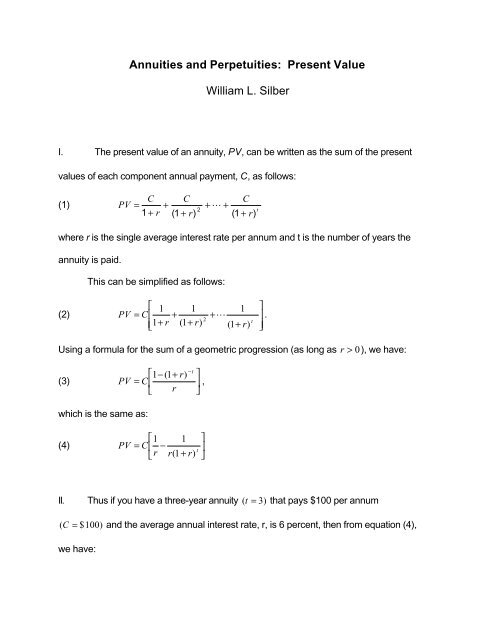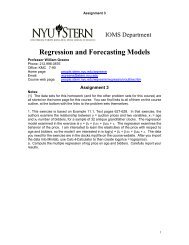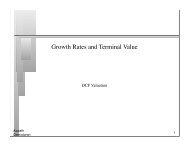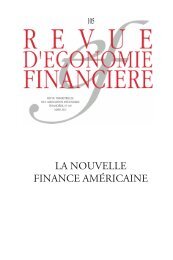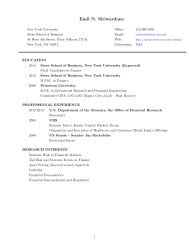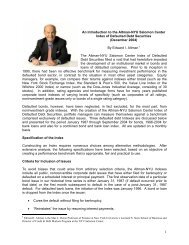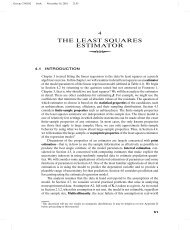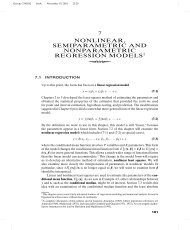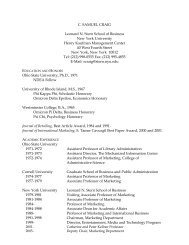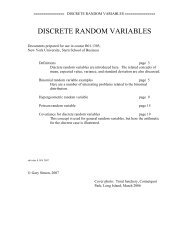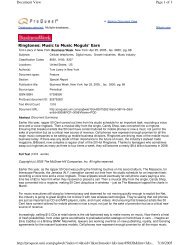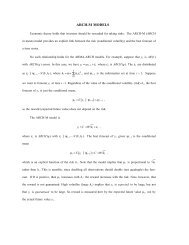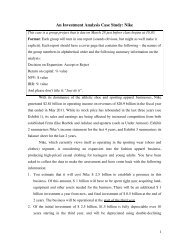Annuities and Perpetuities - Present Value
Annuities and Perpetuities - Present Value
Annuities and Perpetuities - Present Value
Create successful ePaper yourself
Turn your PDF publications into a flip-book with our unique Google optimized e-Paper software.
<strong>Annuities</strong> <strong>and</strong> <strong>Perpetuities</strong>: <strong>Present</strong> <strong>Value</strong><br />
William L. Silber<br />
I. The present value of an annuity, PV, can be written as the sum of the present<br />
values of each component annual payment, C, as follows:<br />
C C<br />
C<br />
(1) PV = + + L +<br />
2<br />
t<br />
1 + r ( 1 + r)<br />
( 1 + r)<br />
where r is the single average interest rate per annum <strong>and</strong> t is the number of years the<br />
annuity is paid.<br />
(2)<br />
This can be simplified as follows:<br />
⎡ 1 1<br />
PV = C⎢<br />
+<br />
⎢⎣<br />
1+<br />
r ( 1+<br />
r)<br />
2<br />
1 ⎤<br />
+ L ⎥ .<br />
t<br />
( 1+<br />
r)<br />
⎥⎦<br />
Using a formula for the sum of a geometric progression (as long as r > 0),<br />
we have:<br />
−t<br />
⎡ 1−<br />
( 1+<br />
r)<br />
⎤<br />
(3) PV = C⎢<br />
⎥ ,<br />
⎣ r ⎦<br />
which is the same as:<br />
⎡1<br />
1 ⎤<br />
(4) PV = C⎢<br />
−<br />
t ⎥<br />
⎣r<br />
r(<br />
1+<br />
r)<br />
⎦<br />
II. Thus if you have a three-year annuity ( t = 3)<br />
that pays $100 per annum<br />
( C = $ 100)<br />
<strong>and</strong> the average annual interest rate, r, is 6 percent, then from equation (4),<br />
we have:
1 1<br />
$ 100.<br />
00<br />
$ 267.<br />
30<br />
3 . 06 . 06(<br />
1.<br />
06)<br />
=<br />
⎡<br />
⎤<br />
PV = ⎢ − ⎥<br />
⎣<br />
⎦<br />
You can check that this is correct by calculating:<br />
PV<br />
=<br />
$ 100<br />
1.<br />
06<br />
+<br />
$ 100<br />
( 1.<br />
06)<br />
2<br />
+<br />
$ 100<br />
( 1.<br />
06)<br />
3<br />
=<br />
$ 267.<br />
30<br />
III. More interesting is what happens to the present value formula when the annual<br />
payments, C, continue forever. The annuity becomes a perpetuity as t → ∞ <strong>and</strong> the<br />
formula in (4) becomes:<br />
⎡1<br />
1 ⎤<br />
(5) PV = C⎢<br />
−<br />
∞ ⎥<br />
⎣r<br />
r(<br />
1+<br />
r)<br />
⎦<br />
(6)<br />
Or, finally,<br />
(7)<br />
⎡1<br />
1 ⎤<br />
PV = C⎢<br />
− ⎥<br />
⎣r<br />
∞⎦<br />
C<br />
PV =<br />
r<br />
IV. Equation (7) is very simple. It says that the present value of an annuity of C<br />
dollars per annum is C divided by r, where r is the average interest rate per annum.<br />
This makes considerable sense once you provide a numerical example. Suppose<br />
C=$10 per annum <strong>and</strong> the interest rate is .05, or 5 percent. How many dollars,<br />
designated by the letter P, would you have to put away today so that it produces $10 in<br />
each year forever? The answer is given by solving the following formula for P:
P × . 05 =<br />
P =<br />
$ 10<br />
. 05<br />
$ 10<br />
=<br />
$ 200.<br />
Investing $200 at 5 percent generates $10 in interest per year <strong>and</strong> continues to do so<br />
forever. Thus, if an annuity promises to pay $10 forever <strong>and</strong> the annual interest rate is<br />
5 percent, the value of that infinite stream of payments is $200. If the annuity were<br />
priced in a competitive market its price should be $200


